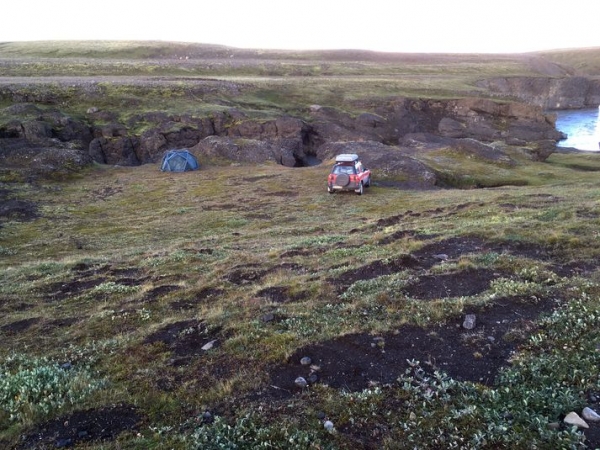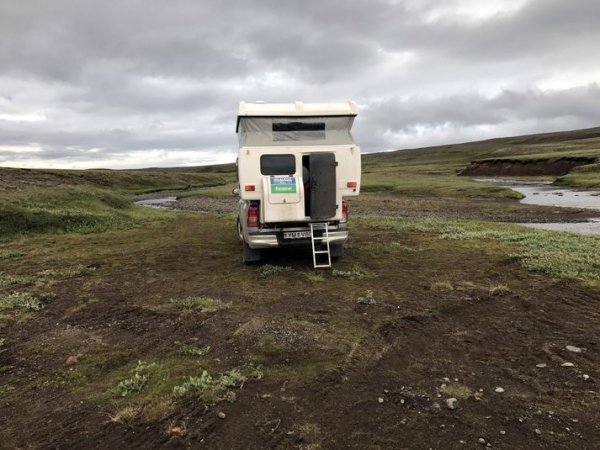The strange case of a local man who managed to drive his 4×4 half way up to the steep hill of mount Esja, before he managed to get stuck in the middle of a bog, has re-ignited a debate about off-road driving in Iceland. Experts argue that while the Esja off-road idiocy might be remarkable newsworthy due to its brazenness it was a relatively minor incidence. Many argue it is necessary to raise the fines for criminal off-road driving.
Read more: Local man facing steep fines for off-road idiocy in the slopes of mount Esja
I don't see any reason to show lenience in these kinds of cases. This is too serious a problem, the chairman of Landvernd, the largest nature conservation organization in Iceland told Vísir. The average fine for off-road driving is 100-200.000 ISK (960-1,900 USD/810-1,600 EUR), although the maximum punishment allowable by law is 350,000 ISK (3,400 USD/2,800 EUR) and four years in prison.
In some cases park rangers who have managed to catch off-roaders in action have also forced the offenders to clean up their tracks.
Read more: Chinese off-roaders forced to cover their tracks by hand
The problem, some have argued, is that many foreign travellers do not know they are engaged in criminal activity when they drive off-road, or that they fail to realize that they are leaving a permanent mark on the landscape. The sub-arctic vegetation of Iceland is extremely fragile, and it can take decades for tracks left in a short off-roading adventure to heal. Driving off-road on deserted wasteland, volcanic sands or the deserts of the Central Highlands also leaves ugly marks which take a long time to heal or disappear.

A second problem is that travellers often fail to realize that the presence of what appears to be a track is not an invitation for others to follow. Driving along old tracks on farmlands or heaths is not considered off-road driving if you are the landowner, or if you are transporting livestock or for other farming related activities, or if you are engaged in sheep herding.

These kinds of roads are not marked on maps, and in many cases they are only suitable for ATVs, tractors or mountain trucks. The local man who got stuck in the slopes of mount Esja had followed one such track which dates back to WWII. While the track had been suitable to 4x4s or trucks 50 years ago, the mountain has long since reclaimed most of it. The same applies for countless tracks in Iceland.

A final point some have made is that many mountain and highland roads are too narrow for cars to pass one another, forcing cars to drive off-road when they meet. In these circumstances drivers must show caution, and choose the spot carefully to minimize the damage. The same applies when drivers meet other obstacles on the road.

The strange case of a local man who managed to drive his 4×4 half way up to the steep hill of mount Esja, before he managed to get stuck in the middle of a bog, has re-ignited a debate about off-road driving in Iceland. Experts argue that while the Esja off-road idiocy might be remarkable newsworthy due to its brazenness it was a relatively minor incidence. Many argue it is necessary to raise the fines for criminal off-road driving.
Read more: Local man facing steep fines for off-road idiocy in the slopes of mount Esja
I don't see any reason to show lenience in these kinds of cases. This is too serious a problem, the chairman of Landvernd, the largest nature conservation organization in Iceland told Vísir. The average fine for off-road driving is 100-200.000 ISK (960-1,900 USD/810-1,600 EUR), although the maximum punishment allowable by law is 350,000 ISK (3,400 USD/2,800 EUR) and four years in prison.
In some cases park rangers who have managed to catch off-roaders in action have also forced the offenders to clean up their tracks.
Read more: Chinese off-roaders forced to cover their tracks by hand
The problem, some have argued, is that many foreign travellers do not know they are engaged in criminal activity when they drive off-road, or that they fail to realize that they are leaving a permanent mark on the landscape. The sub-arctic vegetation of Iceland is extremely fragile, and it can take decades for tracks left in a short off-roading adventure to heal. Driving off-road on deserted wasteland, volcanic sands or the deserts of the Central Highlands also leaves ugly marks which take a long time to heal or disappear.

A second problem is that travellers often fail to realize that the presence of what appears to be a track is not an invitation for others to follow. Driving along old tracks on farmlands or heaths is not considered off-road driving if you are the landowner, or if you are transporting livestock or for other farming related activities, or if you are engaged in sheep herding.

These kinds of roads are not marked on maps, and in many cases they are only suitable for ATVs, tractors or mountain trucks. The local man who got stuck in the slopes of mount Esja had followed one such track which dates back to WWII. While the track had been suitable to 4x4s or trucks 50 years ago, the mountain has long since reclaimed most of it. The same applies for countless tracks in Iceland.

A final point some have made is that many mountain and highland roads are too narrow for cars to pass one another, forcing cars to drive off-road when they meet. In these circumstances drivers must show caution, and choose the spot carefully to minimize the damage. The same applies when drivers meet other obstacles on the road.








